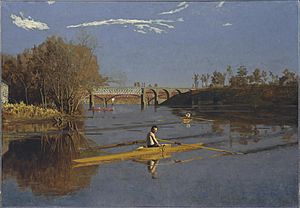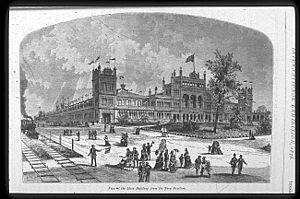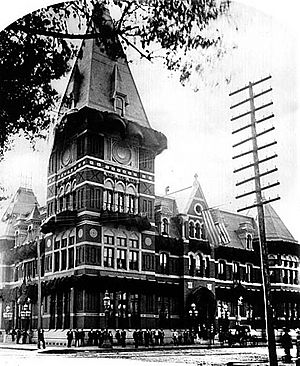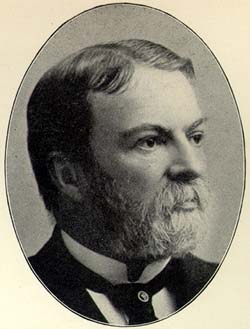- This page was last modified on 17 October 2025, at 10:18. Suggest an edit.
Wilson Brothers & Company facts for kids
Wilson Brothers & Company was a very important architecture and engineering company from Philadelphia, Pennsylvania. They were especially good at designing strong structures like bridges and large buildings. The brothers helped design hundreds of bridges, train stations, and factory buildings. This included the main buildings for the huge 1876 Centennial Exposition, which was like a world's fair.
They also designed churches, hospitals, schools, hotels, and homes. Some of their famous works that you can still see today include the Pennsylvania Railroad, Connecting Railway Bridge over the Schuylkill River (built 1866–67). They also designed the main building of Drexel University (built 1888–91) and the train shed of Reading Terminal (built 1891–93). All these are in Philadelphia.
A Look Back: The Company's Story
The company was started by three main people: Joseph Miller Wilson (1838–1902), who was an architect and civil engineer; John Allston Wilson (1837–96), a civil engineer; and Frederick Godfrey Thorn (c. 1837–1911), who was also an architect and civil engineer.
Joseph and John were brothers. Their younger brother, Henry W. Wilson (1844–1910), who was also a civil engineer, joined the company in 1886. He became a partner in 1899. All three Wilson brothers studied at Rensselaer Polytechnic Institute, a well-known school in New York. Joseph also studied how metals are made and used at the University of Pennsylvania.
Joseph worked for the Pennsylvania Railroad (PRR) from 1860 to 1876. He designed many bridges and train structures for them. One important building he designed was the Baltimore & Potomac Railroad Passenger Terminal in Washington, D.C. (built 1873–77). This station is famous because U.S. President James A. Garfield was killed there in 1881. The land where this station once stood is now home to the National Gallery of Art.
John, Joseph's brother, also worked as an engineer for several railroads, including the PRR and the Reading Railroad. The company, Wilson Brothers & Company, officially started on January 1, 1876.
Designing the Centennial Exposition
For the big 1876 Centennial Exposition in Philadelphia, Joseph M. Wilson worked with another architect, Henry Petit. They designed the Main Exhibition Building together. This building was enormous! It was about 1,876 feet (572 meters) long and covered over 21 acres (about 8.5 hectares). At the time, it was the largest building in the world.
They also designed Machinery Hall and helped manage the building of other important structures for the fair. Joseph even helped write a three-book history about this famous Philadelphia World's Fair.
Other Important Projects
The company designed many different types of buildings. For example, Joseph designed Philadelphia's Presbyterian Hospital in 1874. This led to more work on Presbyterian churches, nursing homes, and even an orphanage.
They also did a lot of work for a very rich man named Anthony J. Drexel. He was a banker and a Roman Catholic. This connection might have led to the company designing convents and Catholic hospitals later on.
In Philadelphia, they designed the main office for the Baldwin Locomotive Works, a company that made trains. In Beach Haven, New Jersey, they designed the Baldwin Hotel (built 1883) and Holy Innocents Episcopal Church (built 1881–82). They also designed several summer homes for the executives who worked at the Baldwin company.
Big Train Stations and Buildings
In 1881, the Pennsylvania Railroad hired Wilson Brothers & Company to design their main passenger station in Philadelphia. This station was one of the first buildings in America to use a steel frame with brick walls that didn't hold up the building (called a "curtain wall"). This is how skyscrapers are built today! Many people admired this station. In fact, 15% of architects in a poll in 1885 said it was one of the "Best Ten Buildings in the United States."
Years later, in 1892, their Gothic-style station was made part of an even bigger station designed by Frank Furness. The Wilsons designed the new train shed for this expanded station. At that time, it was the largest single-span train shed in the world.
In 1885, the Wilsons designed a grand, two-story bank building for Drexel & Company in Philadelphia. Four years later, Drexel wanted to make the building bigger. But the bank next door wouldn't sell their land. So, Joseph Wilson designed the Drexel Building, a 10-story addition that wrapped around the neighbor's bank on three sides. This blocked the neighbor's sunlight! This new building had an iron frame and was one of the first to use a special strong design called "X-bracing."
Interestingly, the Drexel Building itself was torn down in 1959. A copy of an older building, Library Hall, was then built on its original spot.
After the two older Wilson brothers passed away, the company continued under a new name: Wilson, Harris and Richards.
Buildings They Designed

Max Schmitt in a Single Scull by Thomas Eakins (1871). The Pennsylvania Railroad, Connecting Railway Bridge over the Schuylkill River (1866–67) is in the background.

The Main Exhibition Building at the Centennial Exposition in Philadelphia (1875–76). This was the largest building in the world at the time.

The train shed at Reading Terminal in Philadelphia (1891–93).
Buildings in Pennsylvania
For the Pennsylvania Railroad
- Pennsylvania Railroad, Connecting Railway Bridge over Schuylkill River, Philadelphia, PA (1866–67)
- Bryn Mawr Station, Bryn Mawr, PA (1869, no longer standing)
- Wynnewood Station, Wynnewood, PA (1870)
- Haverford Station, Haverford, PA (around 1870)
- Bryn Mawr Hotel, Bryn Mawr, PA (1871, burned down)
- Ardmore Station, Ardmore, PA (before 1874, no longer standing)
- Broad Street Station, Philadelphia, PA (1881, expanded later, no longer standing)
- Wayne Railroad Station, Wayne, PA (1884)
- Train shed for the expanded Broad Street Station, Philadelphia, PA (1892, burned down)
Buildings in Philadelphia
- Reading Railroad Overpass (1871)
- Spring Garden Pumping Station, Fairmount Park (before 1874, no longer standing)
- Presbyterian Hospital (1874, no longer standing)
- Joseph D. Potts house changes (1876), now part of the University of Pennsylvania Press
- A.J. Holman and Company, 1222–26 Arch St. (1881)
- St. Andrew Episcopal Church, now St. Andrew & St. Monica Episcopal Church (1883–85)
- Drexel & Company Banking House, 5th & Chestnut Sts. (1885, expanded 1889, no longer standing)
- Drexel Institute of Technology, now Main Building, Drexel University (1888–91)
- Home for Indigent Women, now Ralston House (1889)
- Pennsylvania School for the Deaf, 7500 Germantown Ave. (1890)
- George W. Childs Drexel mansion (1891), now Alpha Tau Omega fraternity at the University of Pennsylvania
- Reading Terminal Trainshed (1891–93)
- Physicians & Dentists Office Building, 1830–32 Chestnut Street (1896)
- Philadelphia Commercial Museum (1897–99, no longer standing)
- United Gas Improvement Company Office Building (1898)
- Land Title Building, 608–10 Chestnut Street (1899)
- Wayne Junction Station (Reading Railroad), 4481 Wayne Avenue (1899–1900)
Buildings for the 1876 Centennial Exposition
- Memorial Hall (1875–76)
- Main Exhibition Building (1875–76, taken apart and sold)
- Machinery Hall (1875–76, taken apart and sold)
Other Buildings in Pennsylvania
- Central Railroad of New Jersey Station, Jim Thorpe, PA (1888)
- State Hospital for the Insane, Norristown, PA (1878–80)
- Reading Railroad Station, Lebanon, Pennsylvania (1900)
- Central Railroad of New Jersey Freight Station, Scranton, PA (1891)
- Morton station renovation (1880)
- Quakertown Passenger and Freight Station, Quakertown, PA (1889)
- "Chetwynd" (John H. Converse house), Rosemont, PA (1882–83, expanded later, no longer standing)
Buildings Outside Pennsylvania
New Jersey
- Baldwin Hotel, Beach Haven, NJ (1883, burned down)
- Dr. Edward H. Williams House, 506 S. Atlantic Ave. Beach Haven, NJ (1886), now Williams Cottage Inn.
- Converse Cottage, 504 Atlantic Ave. Beach Haven, NJ (1890)
- Holy Innocents Episcopal Church, Beach Haven, NJ (1881–82), now Long Beach Island Museum.
- Tuckahoe Station, Tuckahoe, NJ (1894)
New York
- Milton Railroad Station, Milton, NY (1883)
- Astronomical Observatory, U.S. Military Academy, West Point, NY (before 1885)
- St. Hubert's Inn, St. Huberts, NY (1890), now Ausable Club.
Virginia
- Union Station Train Shed, Richmond, VA (1900)
- Leander McCormick Observatory, Charlottesville, VA (1884)
- Main Street Station, Richmond, Virginia (1901) (as Wilson, Harris and Richards)
Vermont
- Norman Williams Public Library, Woodstock, VT (1883–84)
- Williams Science Hall, University of Vermont, Burlington, VT (1894–96)
Illinois
- Riverbank Laboratories, Geneva, IL (1912)
- Buildings in the Central Geneva Historic District and the North Geneva Historic District in Geneva, IL.
Other Locations
- Baltimore & Potomac Railroad Passenger Terminal (6th Street Station), Washington, DC (1873–77, no longer standing)
- Stewart Hall, West Virginia University campus, Morgantown, WV (1900–02)
- Elliott Building, 1401 Woodward Ave. Detroit, MI (1894)
Images for kids
-
Inside Machinery Hall at the Centennial Exposition (1875–76).
-
Main Building, Drexel University, Philadelphia, PA (1888–91).
-
Inside the Main Building, Drexel University.
-
St. Hubert's Inn, St. Huberts, NY (1890), now Ausable Club.
-
George W. Childs Drexel mansion, University of Pennsylvania, Philadelphia, PA (1891).
-
Williams Science Hall, University of Vermont, Burlington, VT (1894–96).






















